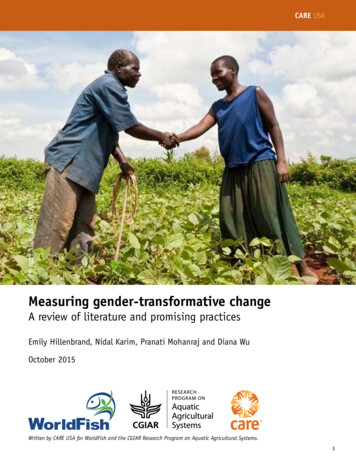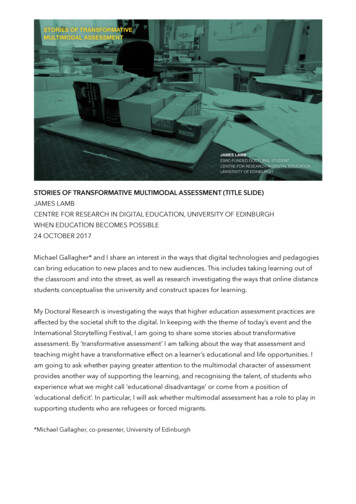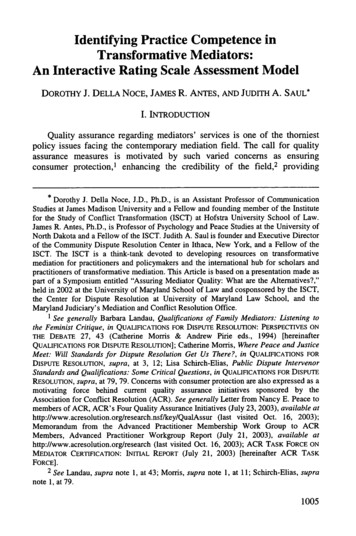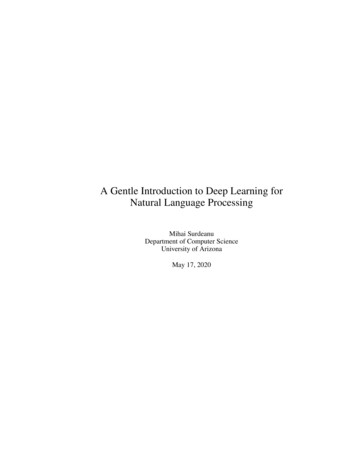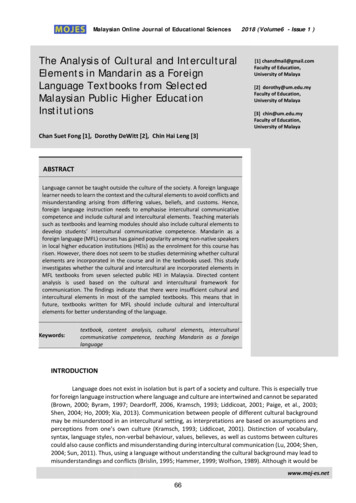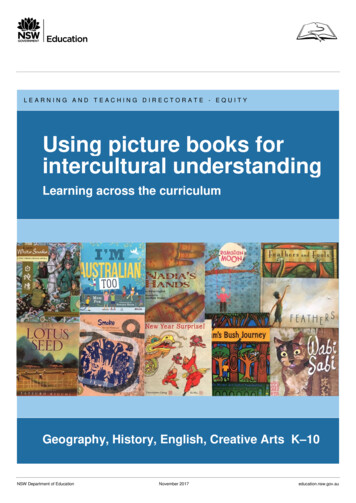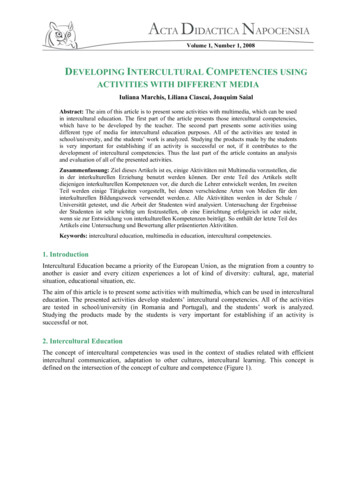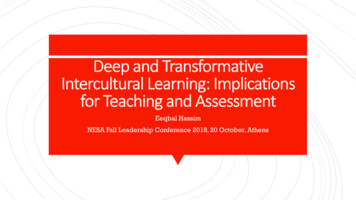
Transcription
Deep and TransformativeIntercultural Learning: Implicationsfor Teaching and AssessmentEeqbal HassimNESA Fall Leadership Conference 2018, 20 October, Athens
What isinterculturallearning?§ Work in small teams to produce a common definition.§ Explain your definition.
§ Teaching: The combination of processes used tofacilitate learning.Workingdefinitions§ Assessment: The combination of processes used todetermine where a student is at in their learning, howmuch and/or how well they have grown, and where theyneed to go next in their learning.Think broad repertoire
§ How do you define it?What is deeplearning?§ How do you teach for deep learning?§ How do you assess deep learning?Think higher-order and mastery
§ How do you define it?What istransformativelearning?§ How do you teach for transformative learning?§ How do you assess transformative learning?Think reflection, application, and edge of comfort zone(which differs from one individual to another)
A suggested post-workshop task for your school.Using learningtaxonomies andcontinua and to leaddeep interculturallearning§ Review all learning and teaching related tocultural/intercultural matters against a taxonomy and/orcontinuum, for example:§ SOLO (Structure of Observed Learning Outcomes) (Biggs& Collis, 1982)§ Banks (1999) – Multicultural education reform§ Intercultural development continuum ( IDI, LLC).
Using the taxonomies and/or continua:Using learningtaxonomies andcontinua and to leaddeep andtransformativeintercultural learning§ Classify the school’s written curriculum and how it istaught§ Classify student work samples§ Identify where deep and transformative learning occursor has the potential to occur.
Level (SOLO)Observed learning examplesUnistructuralStudents define home as the place where one livesMultistructuralStudents describe concepts related to home separately, for example: Home as a place of shelter, refuge, comfort, identity, and belonging Home as homeland, place of origin, country of affiliation Different meanings of ‘home’ and how these are culturally influenced.RelationalStudents explain how the different types, meanings and perceptions of‘home’ influence attitudes, social interactions, politics, policies etc.ExtendedabstractStudents link their relational learning of ‘home’ to studies of identity,belonging, transnationalism, migration etc.Students synthesise a multi-faceted, multi-perspective response to‘Where are you from?’
Level (SOLO)Observed learning examplesUnistructuralStudents identify migration as people moving from one place to anotherdue to particular needs and/or a wants.MultistructuralStudents describe distinct migration concepts separately, for example: The reasons for migration The consequences and implications of migration Responses to migration (by migrants and by receiving communities).RelationalStudents explain how the reasons, consequences, implications andresponses interconnect, influencing attitudes, social interactions, politicsand policies, personal experiences etc.ExtendedabstractStudents draw links with various types of movement of people (e.g.travel, refuge, asylum, transnationalism), animal migration, and migrationas an age-old phenomenon.
Adapted from Banks (1999) (Asia Education Foundation, 2013)ContributionsAdditiveTransformationSocial ActionLearn about culturesUse resources by and aboutpeople from diverse culturesView common themes andissues from diverse culturalperspectivesCombines Transformationwith actionSelected cultural contentincorporated into teaching,focused on visible cultureIntercultural issues not ageneral feature ofcurriculumDependent on teachers’interestIntercultural perspectivesadded to curriculum,without changing its designKnowledge building butdoes not necessarilytransform thinkingCritical thinking aroundculture and interculturalconnectionsStudents transform thinkingabout intercultural issuesand do something with theirlearningAcknowledge diversity as apremiseAppreciate and developmultiple ways of seeingBuild empathyCatalyticTransformative
Contributions/AdditiveStudents learn about the differentways people dress by examining thetraditional clothing of a variety ofcultures. They identify similarities anddifferenceswith theandway they s investigate how peopledress as an age-old socialphenomenon. They analyse thesignificance of, and reasons behind,particular dress types (e.g. climate,modesty, social status, conformity,individuality). They use a rangeexamples and perspectives to betterunderstand why people dress incertain ways and how fashion isinterconnected across cultures andacross space and time.
Contributions/AdditiveStudents learn about different culturalcelebrations, identifying similaritiesand differences between thesecelebrations and the celebrations thatthey observe.DeepenUnderstandingsTransformationStudents investigate celebrations asan age-old social phenomenon. Theyanalyse the significance of, andreasons behind, why peoplecelebrate what they choose tocelebrate. They use a range examplesto better understand why peopleobserve particular celebrations andhow celebrations are interconnectedacross cultures and across space andtime.
Let’s work on anexampletogetherTopic: Our school’s cultural diversity1. Use SOLO2. Use the two-column version of the model adaptedfrom Banks (1999)
A continuumSource: IDI, LLCThink about your school. Can you give examplesfor each level of the continuum?
Broad strategies identified from relevant interculturaleducation literature, verified against effective teachingstrategies in the Australian Teaching and Learning Toolkit:§ Feedback – on the processes and outcomes of learning, what’sWhat’seffective?changed, and the rate and quality of change; also teacherfeedback, i.e. feedback on the impact of teaching on learning§ Meta-cognition – students regularly reflect on how they think, talkabout and behave in intercultural situations; needs to be facilitatedand guided; relates strongly to deep and transformative learning§ Comprehension strategies (when combined with meta-cognition);relates strongly to deep learning§ Mastery learning (related to meta-cognition and feedback); relatesstrongly to deep and transformative learning§ Peer learning and collaborative learning§ Social and emotional learning.
§ Write learning progressions and rubrics for identifiedcore skills/competencies relevant to interculturallearningAssessmentconsiderations§ Use a consistent set for assessment, monitoring, andreporting§ Use a consistent set for teachers, students, and parentsEveryone is on the same page about the learning that hashappened and the learning that needs to happen
com/in/eeqbal-hassim
Assessment considerations §Write learning progressions and rubrics for identified core skills/competencies relevant to intercultural learning §Use a consistent set for assessment, monitoring, and reporting §Use a consistent set for teachers, students, and parents
